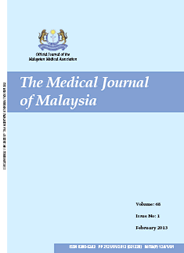MJM, Vol 70 Supplement 1 September 2015
Behavioural modification intervention program for
CVD risks prevention among secondary school children in Batang Padang District,
Perak
Department of Community Medicine, Faculty of Medicine and Health Sciences, Universiti Putra Malaysia, Serdang, Selangor
ABSTRACT
Introduction: The problems of cardiovascular vascular diseases (CVD) among adults has reached an epidemic proportions. CVD is the leading cause of death over last 40 years in Malaysia. This paper aims to report on the baseline data of behaviour modification intervention program to reduce CVD risk factors among secondary school children in Batang Padang District.
Methods: Randomised Cluster Controlled Study involving ten schools is being conducted in Batang Padang District. Self-administered questionnaire was used for data collection on socio-demographic, dietary habit, smoking, self-esteem and CVD knowledge. Weight, height and blood pressure was measured at baseline and 6 months post intervention. Baseline data analysis was carried out using SPSS version 22. Independent sample t-test was be used for comparison of means between the groups. One way ANOVA test was used to compare more than two means. Confidence interval was set at 95% for the estimation of mean. Level of significance was set at p less than 0.05.
Results: The overall prevalence of overweight and obesity of the 3630 participants was 10.9% and 5.5% respectively. Overall, 5.6% of the participants were pre-hypertensive, 4.1% with grade 1 hypertension while 0.9% with grade 2 hypertension while Diastolic BP classification showed 4.8% is in pre-hypertensive group, 4.3% grade 1 hypertension and 0.8% grade 2 hypertension. Only 57.6% reported having moderate to high level of physical activity. Majority (89.5%) stated that they had never smoked. Out of the 10.5% respondents who ever smoke, 4.6% gave up smoking while 5.9% continue to smoke. There was no significant difference in the mean age, proportion distribution of participants by gender, ethnicity, family income, and father’s education, family history of obesity, hypertension or CVD at baseline.
Conclusion: The baseline data shows the prevalence of several CVD risk factors among adolescents. An effective intervention program targeting to reduce multiple risk factors among adolescent is needed.
KEYWORDS: CVD risk factors, adolescents, schools
